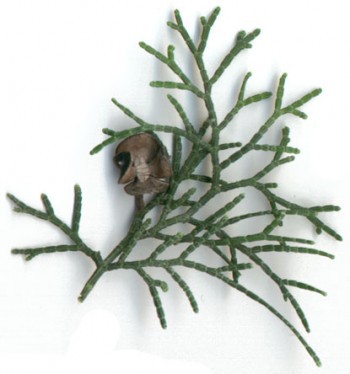Tetraclinis, as described in 1892 by (Vahl) Maxwell Tylden Masters (1833 - 1907), in Journal of the Royal Horticultural Society, 14th edition, is a genus of evergreen coniferous trees in the cypress family, Cupressaceae, containing only one species, Tetraclinis articulata (also known as Thuja articulata). Common names include sandarac, Sandarac Gum tree or Barbary Thuja and as thuya d'Algérie, thuya de Barbarie, or bois de titre in the French language. Its closest relatives are Platycladus, Microbiota and Calocedrus, with the closest resemblance to the latter. In older texts, it was sometimes considered with Thuja or Callitris, but it is less closely related to those genera.

Description. Sandarac gum tree is a small, slow-growing tree which will grow to mature heights of 20 to 50 feet (6 - 15 m), (exceptionally to 65 feet / 20 m) tall with a 1.5 feet (0.5 m), (rarely 3 foot / 1 m) wide trunk diameter at breast height. It often grows with two or more trunks from the base.
It is one of only a small number of conifers able to coppice (re-grow by sprouting from stumps), an adaptation to survive wildfire and moderate levels of browsing by animals. Old trees that have sprouted repeatedly over a long period form large burls at the base, known as lupias. The species is threatened by overgrazing, which can kill the coppice regrowth before it gets tall enough to be out of the reach of livestock.
Distribution. This species is native to northwestern Africa in the Atlas Mountains of Morocco, Algeria and Tunisia, with two small outlying populations on Malta, and near Cartagena in southeast Spain. It grows at relatively low altitudes in a hot, dry subtropical Mediterranean climate. It is the national tree of Malta, where it is known as Għargħar (derived from the Arabic name Araar). It is now being used locally in afforestation projects.
The resin, known as sandarac, is used to make varnish and lacquer; it is particularly valued for preserving paintings. The wood, known as thuya wood] or citron wood and historically also known as thyine wood, is used for decorative woodwork, particularly wood from burls at the base of the trunk. Use of the burl wood kills the tree. The market in Morocco is unsustainable, focusing as it does on the burl, and has resulted in mass deforestation of the species.
The species is cultivated to be grown as an ornamental tree, valued in hot, dry climates. It is also pruned in a hedge form, for privacy and security. The plant can be trained for use as Bonsai specimens.
Please refer to the species link below to view the photo gallery associated with this tree.